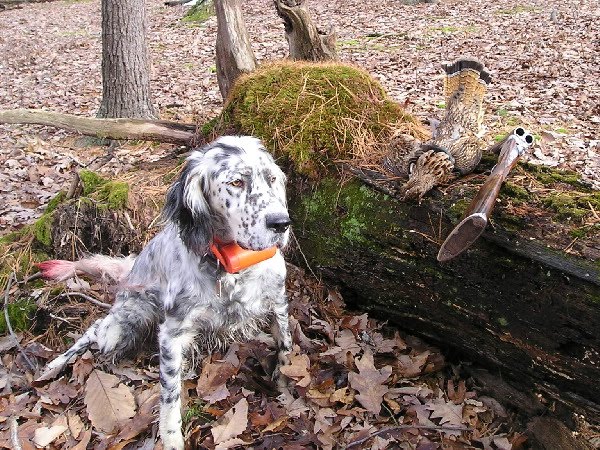Meet Bliss the newest member of our Pack.
Thoughts and pictures of my wanderings through the Allegheny Mountains hunting grouse and woodcock with my Ryman-type English Setters during the fall and winter months, fishing for smallmouth bass in local streams and rivers during the summer months and wandering over my 66 acres of heaven year round.
Saturday, April 28, 2018
Thursday, April 19, 2018
Grafting to Wild Apple Trees
Yesterday I "top worked" some wild apple trees that had not produced any fruit. I cut the trees back rather severely last spring to promote sucker growth and used the cleft grafting technique to graft to the new growth. I waited until the leaves had begun to open to improve my chances for success.
After wrapping with parafilm I added a couple of wraps of masking tape just to made the graft more secure and put a covering of toilet bowl wax on the tip of the scion to keep it from drying out.
With the large established root system of the older apple trees and if my grafting is successful the scion should be producing apples in a few years, much faster than grafting to rootstock and waiting for the tree to develop.
After wrapping with parafilm I added a couple of wraps of masking tape just to made the graft more secure and put a covering of toilet bowl wax on the tip of the scion to keep it from drying out.
With the large established root system of the older apple trees and if my grafting is successful the scion should be producing apples in a few years, much faster than grafting to rootstock and waiting for the tree to develop.
Friday, April 6, 2018
The Grafting Season
Here on the homestead I'm well into my grafting season. The Tina left-handed grafting knife that I bought last year has been one of my best investments. I've now conquered the difficult (to me) whip and tongue graft and am using it on the appropriately sized scion and rootstock. I still use the cleft graft when the scion is smaller than the rootstock.
The Tina
The whip and tongue graft while not necessarily a better graft than a cleft graft is a "cleaner looking" graft, but is best used when the scion and rootstock are nearly the same diameter size. Here I am cutting the "tongue" on a whip and tongue graft.
And the finished graft.
I'm excited about the rare Limbertwig scions I was able to obtain this spring. The Limbertwig family of apple trees originated in the southern Appalachian mountains. Grown from seeds on isolated homesteads in the 1800's they are noted for their unique taste and versatility as a fresh eating apple, a fine cider apple and also good for making apple butter and drying. Many although not all of the varieties have a weeping growth habit from their slender limbs that bend down under the weight of their apple crop. At one time over 50 varieties of Limbertwigs were known but many have become extinct. I currently have 8 varieties growing in my orchards and was able to get scion of 10 more varieties this spring.
There must have been an interesting story behind the naming of this variety of Limbertwig.
A bucket full of just grafted Limbertwigs
Anyone interested in learning more about the Limbertwig family of apples can read an interesting article on Ron Joyner's blog at www.bighorsecreekfarm.com
Anyone interested in learning more about the Limbertwig family of apples can read an interesting article on Ron Joyner's blog at www.bighorsecreekfarm.com
Subscribe to:
Posts (Atom)




















